Almanac Article
Iris munzii: A Partial View
Richard C. Richards, La Mesa, California
Almanac, Fall 2001 Vol.30, No.1: 8-10
[Adapted and slightly modified for the web]
Photographs by the author
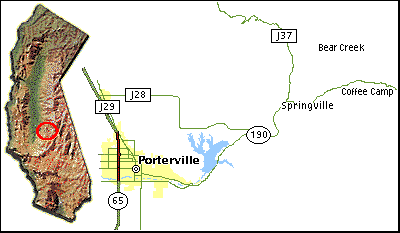
My contact with I. munzii began in the late 1960s when I first saw it growing at Coffee Camp, California, in the foothills of the Sierra Nevada Mountains. I had followed the directions in Victor Cohen's A Guide to Pacific Coast Irises, and the beauty and wide range of colors I found there delighted me. Nowhere else have I ever seen such diversity of color and form in I. munzii.
A visit to those stands became an important event every April for years. Subsequently, stands higher in the Sierra Nevada Mountains, at Bear Creek, were added to the itinerary. Correspondence with John Weiler had informed me of the location of those stands.
Later, through correspondence with a Park Ranger at Sequoia National Park, I saw the stands of I. munzii located within the park boundaries, behind several locked gates where the public normally is not allowed. None of these other iris could match the Coffee Camp stands for variation and richness of color.
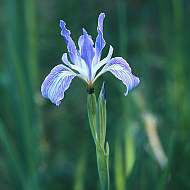
The Bear Creek stands of I. munzii grow at nearly 4,000 feet in elevation, so they receive an occasional light dusting of snow in the winter. This suggests that I. munzii may be a little more cold-hardy than it is traditionally thought to be.
Dr. Lee Lenz, Director of the Rancho Santa Ana Botanical Gardens in Claremont, California, had completed his study and classification of the Pacific Coast Native irises in the 1950s. He saw the potential of I. munzii for adding size and color to PCI hybrids. In the late 1960s and into the early 1970s, Lenz was growing several collected clones of I. munzii at the Botanical Gardens, in an area segregated by a chain link fence. I believe these clones were mostly collected at Coffee Camp, and I spent many spring days staring over the fence at those clones and at the remarkable hybrids he produced from them.
One December day, Lenz invited anyone who was interested to come to the garden so he could share some of his irises with us. He dug pieces of his recent introduction, SIERRA SAPPHIRE, for everyone. He recently explained that SIERRA SAPPHIRE was derived from pollen from a Coffee Camp munzii clone, used to fertilize a previously collected munzii clone at the Botanical Garden. It was indeed a magnificent shade of blue. Even at Coffee Camp I had never seen such a bright a shade of blue. Most flowers of I. munzii in the wild are a blue-gray, with those at Coffee Camp showing variations into lavender, purple, and even violet.
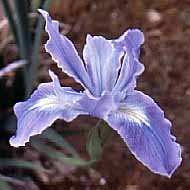
Sidney B. Mitchell medal, 1977
Lenz began releasing named hybrids involving SIERRA SAPPHIRE and other I. munzii clones to the commercial trade. These introductions died with predictable ease for everyone who attempted to grow them.
The reason for their demise was evident. In the wild, I. munzii grows in areas with a fairly wet spring followed by a hot, dry summer. The irises go dormant during the summer, as do most PCI clones in the wild. Summer watering is the quickest way to kill them. Lenz attempted to replicate the wild conditions in his plot at the botanical garden. He withheld summer water from the plants from June until mid-September, successfully growing them this way.
The average gardener rarely has the space or inclination to withhold water from a portion of his garden in the summer. This explains the catastrophic losses of Lenz hybrids in typical home gardens.
Lenz also grew his collected clones and hybrids in full sun, though most at Coffee Camp and at other places where I have seen them, grow in dappled shade. How the experience affected their survival in Lenz' garden is not clear. Perhaps he lost all the collected clones and hybrids that could not tolerate full sun all summer, and those we saw at the RSABG were the ones that survived.
The morbidity of these introductions in ordinary gardens became legendary. I talked with Vern McCaskill of McCaskill's Gardens in Arcadia, through whom Lenz introduced many of his I. munzii hybrids. McCaskill had grown and sold PCI hybrids for years, but he could not keep the Lenz introductions alive for very long. Later, Lenz introduced strains through Bob Hubley in Riverside. Hubley tried to emulate exactly Lenz' growing conditions, but he too had trouble keeping the irises alive.
Though quite striking, I believe few if any of these introductions still exist. Lenz gave away several of his promising seedlings at meetings of various iris societies, but these too are gone.
Lenz also gave several of his unintroduced seedlings to Thornton Abell, a Santa Monica architect. One of Lenz' most beautiful introductions was named for Thorton's wife, Alma Abell.
I saw those hybrids growing under citrus trees on the hillside at the Abell home and took slides of them. They seem to have been more easily grown. After Abell's death, Lewis and Adele Lawyer of Oakland acquired and subsequently used these hybrids as part of a successful breeding program.
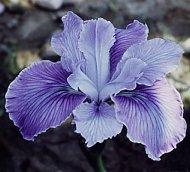
In the meantime, I talked with Dara Emery, the Horticulturist at the Santa Barbara Botanical Garden. Dara had a strong interest in native irises. He was already growing several species and hybrids, and was interested in growing I. munzii. So, armed with a collector's permit from the USDA, in the spring I marked a representative number of clones from Coffee Camp and dug them the following winter. They survived for a year or two in the SBBG, but then disappeared.
Emery grew SIERRA SAPPHIRE for a while, and was disappointed when it first bloomed. I had praised its wonderful blue color, but he took me to the garden and showed me a dull blue flower. It had the typical form of SIERRA SAPPHIRE, but not the color. A week later I got an excited phone call from Dara Emery. The later flowers were bright blue! Emery theorized that the blue pigment in SIERRA SAPPHIRE (and other blue irises derived from I. munzii breeding) is heat sensitive; the bright blue color only shows up under fairly high temperatures. The cooler early spring temperature when the first flowers opened did not allow the blue pigment to develop fully.
Emery used SIERRA SAPPHIRE and other I. munzii clones in a breeding program involving crosses with his own Iris douglasiana hybrids. I do not believe he introduced any of these hybrids, and his death put an end to that promising line of breeding. The Lawyers tried to acquire the seedlings, but I do not think they were successful.
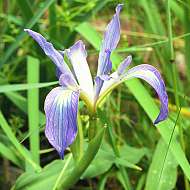
In one of my later visits to Coffee Camp, I noticed that CalTrans (the California Department of Transportation) had begun widening the road several miles below the I. munzii stands. Fearing that the project would destroy many of the clones growing close to the road, I collected the best blooms showing variety of form and quality of color. I took them to Joe Ghio in Santa Cruz, hoping he could use the pollen and preserve some of the irises genetic heritage. His own PCI hybrids were just starting to bloom, but he used the pollen as widely as he could. His resulting hybrids are another contribution preserving the genetic heritage of the Coffee Camp munzii.
Ghio and other hybridizers in the Santa Cruz area are still advancing those lines, producing some magnificent blue, purple, and violet irises owing at least part of their heritage to the Coffee Camp munzii.
In the late 1980s or early 1990s, my wife Marty and I visited Coffee Camp after a ten to fifteen year hiatus. We were in for a shock.
We could not see any irises at all from the road, nor along a short walking exploration of the areas nearby where I had photographed and collected I. munzii in the past.
CalTrans had not widened the road in that area. The only explanation we could come up with is that passers-by had seen the attractive flowers, and dug them on the spot. This is a death sentence in any language. Not knowing how sensitive PCIs are to transplant, and attempting to transplant them at exactly the wrong time of year, these people had one by one wiped out one of the most wonderful stands of I. munzii I have ever seen.
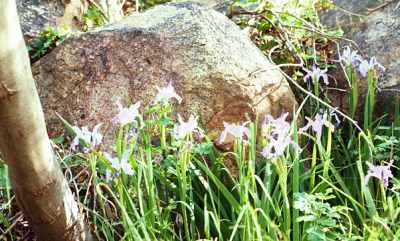
The Coffee Camp munzii were loved to death. I can only hope that somewhere nearby, perhaps over a hill or two which would discourage most exploration on the part of the public, or in the barbed-wire confines of someone's ranch, plants similar to the Coffee Camp munzii still bloom each spring. It is some consolation that the stands of I. munzii within the boundaries of Sequoia National Park remain safe from the spades of flower fanciers who dig without knowing what they are doing.
The Bear Creek munzii higher in the mountains have suffered a partially similar fate; any that could previously be seen by passers-by are gone. By going out in the field and over the edge of a hill out of view from the road, I found some plants still growing and flowering unmolested.
Though I have not seen them, I have heard reports of other stands of I. munzii still growing in the wild. SPCNI had scheduled a spring trek two years ago to visit some of the sites, but a lack of bloom led to its last minute cancellation. I hope that in the future we can find someone who lives reasonably close to the I. munzii native range to put together another trek. A clump of I. munzii in bloom in the wild, tall and stately, is a sight not soon forgotten.